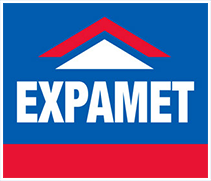FAQs
Can beads be curved?
The dry lining arch bead ref PFB001 can be curved. Steel beads modified by the plasterer are liable to produce a facetted edge.
Can galvanized beads and lath be used externally?
We recommend stainless steel materials are used for external applications. However it is permissible to use galvanized Redrib ref 274 and render stop ref 570 in external applications that are assessed as sheltered or moderate exposure, away from the coast or heavily polluted atmospheres. Similar exposure restrictions apply to the use of galvanized, coated beads with PVC nosing, references 571, 572 and 573.
Are stainless steel beads suitable for use with gypsum plaster?
Stainless steel beads can only be used with gypsum based plasters if they receive an additional protective coating which must be provided by the purchaser.
Where can plastic beads be used?
Expamet offer a range of PVCu beads for both internal and external applications.
How are Shadow Gap details formed?
Expamet Feature Beads are available for use with plasterboard and wet plaster finishes. Engaging beads have a 20mm flange to recess into a rebate in a frame or skirting. Abutting beads have a 15mm wide channel that is positioned against the adjacent element.
Can galvanized beads be painted?
Galvanized steel can be painted provided suitable preparation using a wash and etch primer is applied. Your paint supplier will advise what is compatible with their products.
Which metal lathing should be used for rendering onto timber frame?
Riblath ref 267 provides a carrier for render onto timber frame. It should be fixed to over a breather paper to vertical battens to provide a drained and ventilated cavity between the render and structural frame. Always space metal lathing at least 25mm off timber based sheet materials.
Does metal lathing reinforce walls?
Expamet expanded metal lath and Riblath are only carriers for plaster and render finishes where a satisfactory bond cannot be achieved to the existing background.
Can metal lathing be used across movement joint in walls?
Structural movement joints must be taken through the metal lath and plaster finish. This type of joint should be finished with back to back stop beads with a flexible sealant in-between.
Drawings of Expamet Plasterers Accessories
Basic dimensions are given in the sketches in the Plasterers Accessories brochure available as a PDF download from the LITERATURE section of this website.
Can Timber Masonry joist hangers simply be hooked over the top of finished masonry?
No… All Expamet SPH joist hangers require a minimum of 675mm set masonry built above the masonry flange before any load is applied.
Do SPH Joist Hangers type R and St provide lateral restraint?
No… HD restraint straps must be used in conjunction with all SPH joist hangers where lateral restraint to the wall is required.
How are Maxi Speedy Joist Hangers sized?
Maxi Speedy joist hangers are sized from the timber joist dimensions. Add twice the joist depth and the width then select the Maxi Speedy type number that is at least 20mm less than the total, e.g. nominal timber size 200 x 47, 200+200+47=447, therefore select type 380. Hanger reference is MS38047
What size of bolt can be used with Maxi Speedy Joist Hangers?
Maxi Speedy joist hangers are supplied with 14mm diameter holes to take M12 fixings. For masonry and concrete anchors, confirm fixing is suitable for your particular background with the fixing manufacturer.
How are hangers fixed to Steel Beams?
Maxi Speedy joist hangers can be bolted directly to steel beams with M12 bolts where practical. The Maxi Speedy joist hanger can also be face-fix nailed to a timber packer that is anchored to the web of a steel beam.
How are Joists underslung?
The Long Legged Speedy can be used for fixing joists that are a maximum of 100mm drop below the underside of the header support. Where the joist passes through under the header support, pairs of Angle Plate AP30030 can be used to fix joist of minimum 150mm depth.
Which restraint straps should be used?
Expamet supply heavy duty (HD) straps for horizontal restraint and standard duty (ST) straps for vertical restraint. The length and spacing of the straps should be determined by the designer and agreed with the Local Authority Building Control requirements.
How are Herring Bone Joist Struts fixed?
Pairs of Herring Bone Joist Struts are fixed on opposing diagonals between adjacent joists. The struts must be kept separate (minimum 6mm gap) and fixed at each end with a single nail through the nail hole closest to the joist centreline.
Which nails can be used?
Bat Builders Metalwork is designed to be fixed with 3.75mm diameter 30mm long square twisted sherardised nails. Unless noted otherwise, all nail holes should be used.
How are Split Ring and Shear plate timber connectors fitted?
Expamet can supply special Grooving and Dapping tools which accurately cut the location recesses in the timbers to be joined. (Split Ring Grooving Tools SRGT63 SRGT102 Dapping Tools DT67 DT102)
Can wall starter profiles be used for movement joints?
No… Where horizontal movement must be accommodated against an existing building, use Expamet movement ties and sleeves BMT100, BMT150 or BMT200.
What is the correct number of Wall Starter profile fixings?
Wall Starters are tested and supplied with five fixings in each pack of two plates. These five fixings should be positioned in the top hole of the upper plate, the bottom hole of the lower plate, at the overlap between the plates and mid height on each individual plate. A choice of holes ensures the fixings are made into the masonry unit, not the bed joint.
Which masonry reinforcement should be used?
Expamet Brickstrength is available with 3.5mm or 4mm diameter stainless steel main wires for structural applications. Expamet Exmet is classed as a non-structural reinforcement, e.g. for use above and below openings to minimise the risk of cracking.


